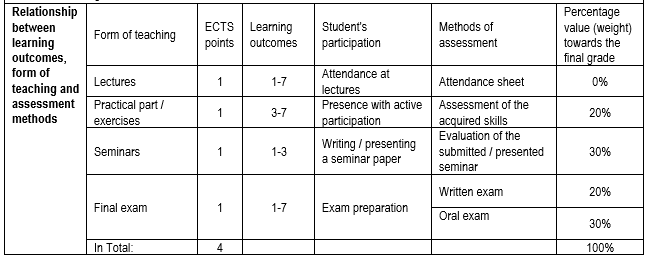Train students to carry out community-based health care interventions, promote health, conduct health education and educate different community user groups. Train students to work in a multidisciplinary team.
Definitions of basic terms. A historical overview of nursing in the community. Contemporary guidelines of nursing practice in the community. Sister models and nursing theories in the community. Types of nursing practice in the community. Roles and competencies of a nurse in the community. The community as a beneficiary of nursing care. Process of nursing care in the community. Measures of primary, secondary, and tertiary prevention in the health protection of women, children, adults and the elderly in the community. Promoting health and preventing diseases of vulnerable groups of users in the community.
Obavezna literatura:
- Mojsović Z, i sur. Sestrinstvo u zajednici 1. Zagreb: Visoka zdravstvena škola; 2004.
- Mojsović Z, i sur. Sestrinstvo u zajednici 2. Zagreb: Zdravstveno veleučilište Zagreb; 2006.
- Mikšić Š. (nastavni tekstovi) Osijek: Fakultet za dentalnu medicinu i zdravstvo Osijek; 2018/19.
- Bralić I, i sur. Kako zdravo odrastati. Zagreb: Medicinska naklada; 2012.
- Županić M, i sur. Moji prvi dani – priručnik za roditelje. Zagreb: HUPS; 2013.
Dopunska literatura:
- McEwen M. Community-Based Nursing. St. Louis: An Introduction. 3. izd. St. Louis: Saunders; 2008.
- Suvremena saznanja o laktaciji i dojenju I; II; III – priručnik za IBLCE. Split: Medicinski fakultet Sveučilišta u Splitu; 2009.
- UNICEF. Priručnik za predavače na trudničkim tečajevima. Zagreb: Ministarstvo zdravstva i socijalne skrbi RH, UNICEF – Ured za Hrvatsku; 2010. str. 70-90.
- Grgurić J, Pavičić Bošnjak A, Stanojević M, Zakanj Z, ur. Priručnik za provođenje inicijative „Rodilište – prijatelj djece“. Zagreb: UNICEF – Ured za Hrvatsku; 2007. str. 53-140.
Upon completion of this course, students will be able to:
- argue the modern determinants of nursing practice in the community;
- judge the basic models and theories of community nursing;
- distinguish types of nursing practice in the community;
- identify the community as a beneficiary of nursing care;
- determine the health needs of the community;
- plan, implement and evaluate health promotion and disease prevention programs for various users in the community, independently and as a member of a multidisciplinary team;
- document nursing care.



